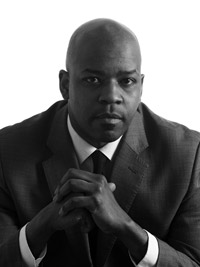Daniel Danso is Global Diversity Manager at Linklaters, having joined the firm in 2013 from Stonewall. He advises the firm on global, firm-wide diversity and inclusion strategies, data collection and monitoring, alongside recruitment, retention and reward, as well as procurement, tendering, business development and marketing. Daniel helps ensure that the firm’s people and clients experience one firm, no matter where in the world they happen to be and regardless of which of the firm’s 29 global offices they are interacting with.

“…We looked at industry research that says that if the legal profession promotes women to the same level that it has attrition, it will be 2027 before we reach 30% of women in senior positions…”
Recognising your own diversity
What a lot of people don’t necessarily recognise is that they are diverse themselves. If I look at myself, as an American and being black, and dealing with the racial situation in the United States, and dealing with my own dyslexia, and being gay, there’s so many things I could have formed an exciting career around. But it was when I was at university, at UCLA [University of California, Los Angeles], that I took a women’s history course, and that women’s history course made me change my major.
So not only did I became the only male Women’s Studies major at UCLA that year but I realised that besides my skin colour and sexual orientation there was a mass of things that my younger sister may have to deal with. The course made me really think that just because she’s a woman, she might not be able to realise her full potential – it really changed my perspective.
I don’t have to be a woman to champion gender equality
I ended up going to LSE [The London School of Economics and Political Science] in the UK for my Master’s Degree in Gender and Media, so I’ve been firmly rooted in the diversity space, not only because of my personal circumstance but also because I knew I could champion things outside of my own experience. I don’t have to be a woman to champion gender equality, but it’s important that we all play a part.
I was lucky enough in my career to start first as a consultant, helping businesses to be more inclusive, with a company called Equality Works, and then working from 2008 to 2013 working for Stonewall in the UK, where I was client group manager, managing a team of associates who in turn managed the business relationships with Stonewall.
The heart to do the right thing
At Stonewall, I touched on so many different businesses, which is fascinating as you engage with so many different types of organisations. But I reached a point where I wanted to take one business from point A to point B. Linklaters stood out of the hundreds of companies that I had engaged with and was one which I felt genuinely had the heart to do the right. I’m not saying the other businesses didn’t but I really felt that the opportunities to make change were really great here.
Understanding how diversity could be looked at in different locations

That means that we also have to understand how diversity could have an influence in our U.S. offices with places like Warsaw, Moscow or Berlin, where historically, socially and religiously, we have to navigate a variety of diversity dimensions.
Experiencing being a woman in different parts of the world
Just because you’re a woman doesn’t mean you’re going to experience being a woman the same way in Lisbon, or in Washington, or in Tokyo, so we really needed to focus on understanding how diversity worked in a local context. Just because we are headquartered in the UK, we can’t necessarily push the same initiatives internationally. You have to adapt where you need to.
My first challenge was to understand the legal sector and how Linklaters worked. Now I’m able to get out to a number of our different offices are really explore how we can make diversity and inclusion work for the local market.
Business benefits of being ‘nice’
Diversity and inclusion also seems like it’s one of those things that’s just held in this space of being a ‘nice thing to do’. Historically, you never really heard about the business benefits. Nobody really looked at the different functions of the business, their product or their relationship with clients through the lens of diversity and inclusion.
Once you start to do that, things start to get transformational. It makes business sense but in some organisations it actually shifts how people understand the importance of diversity and inclusion.
Getting a handle on the way gender changes across the globe
It’s interesting because when you think about diversity and inclusion, not every aspect can be looked across with the same equality in different locations because of different laws and culture.
For example, you don’t have to explain what you mean by ‘gender’ in the same way that you might have to explain the meaning of LGBTI (lesbian / gay / bisexual / transgender / intersex). In the same way, when talking about disabilities – learning, physical, mental or emotional – you don’t have to explain what we mean in some countries but it could mean something different elsewhere.
So how do you tackle these issues? One thing we have been doing at Linklaters is to roll out unconscious bias training across the firm. But again, regional variations come into play, so we have to ensure that what we’re doing for gender is fit for purpose and also directly answers some of the challenges seen not only in our business, but also in the legal profession.
Adopting gender diversity targets because it made sense for us
We had really, deep firm-wide conversations about the merits of introducing a quota or targets for female partners. We wanted to do it because it was natural and it made sense for us.

Gender inequality is something business has to deal with
If you look at the FTSE 500 or the German equivalent, 6% of CEOs are female, so something must be done to address gender inequality. There is no silver bullet solution for tackling gender diversity so our focus is to enable progress that meets and hopefully exceeds the ambitious objectives we have set ourselves.
Last year, we were the first magic circle law firm to adopt gender-related targets to double the number of women currently sitting on the firm’s top two management committees from the current 15% to 30% by 2018, and of above 30% for all new partner elections with immediate effect.
We wanted to make sure that people understood that targets weren’t at the expense of merit but they help to identify talented women who may otherwise have been overlooked.
We will try our hardest to meet the targets but they are aspirational for a reason, we’re trying to really challenge ourselves. So when and if we don’t meet them, we will revisit the strategy and see how we can do things differently to move forward. We have to be realistic and recognise that, for whatever reason, we might not hit the numbers bang on but if we come closer to it year by year, we’ll be on the right track.
The psychological effects of being the subject of a target and reverse discrimination
The other thing we need to understand is the psychological effect of being the subject of a target. This is something that happened in the U.S. – in an attempt to offset real historical imbalances between the ethnicities, there was a programme to lower entry requirements for black minorities. This meant anybody that got into university or got a job – if they happened to be an ethnic minority – never felt confident that they got this because they were the best person. People in the teams that they went into were never sure of that either, so then you end up with the whole cycle of reverse discrimination.
So you can see that we had to make sure everything that when introducing a targets-based approach, that everything not only added up but that our people understood how it worked and where it fit in with everything else that the firm was doing.
Global Talent and Women’s Leadership Programmes
We don’t just have talented lawyers, we also have massively talented people in Business Services from a variety of backgrounds. We have a Global Talent Programme designed to help our best people reach their full potential and beyond. At Linklaters, we really do try and reinforce an environment that puts talent forward.
We also have a dedicated Women’s Leadership Programme for talented lawyers – we’ve had a number of women on this programme who have since been made up to partner or counsel in the last few years. It’s building so much visibility of gender equality and it’s helping men to understand why we need to have specific intervention for gender.
Getting rid of assumptions and stereotypes around gender
It’s interesting because what I wanted to do was to get rid of assumptions, I wanted to get rid of stereotypes and I wanted to get rid of things that were outside of our control. I think when you look at attrition by gender, the massive assumption was that women were leaving because they all wanted to go and have babies and I said, “All of them?! Every last one?! Are you sure?!” I am sure that there are some things that will be out of our control and we can’t ‘fix’ them all, but what we can’t do, is to live under assumptions.
Let’s look at parenting as an example. And let’s not just look at women as the parents. So our family and carers network has done sessions for dads, it’s an opportunity for men to sit down en masse in a room to talk about the frustrations they feel about never getting asked about work / life balance, the assumption that they don’t want work / life balance, alongside all the other issues that parents face.
Men can have a career trajectory that doesn’t include the ability to be there for their child’s first step. It was very powerful in a room of 75 men from partner through to new joiners talking about what it’s like to be a male and dealing with parenting and so we’re taking some of these things out of that space and make it about “people who have children” and people who want flexibility.
Questioning the way women have to make choices about their careers
We’ve done a lot of work with Millennials looking at the differences between what young men and young women want in a career and when they have to start making choices. Obviously women have to make choices about their careers in ways that men don’t, but we’re changing that debate and so now whenever we talk about flexibility and work / life balance, it’s not about, “Women want more flexibility,” it’s about “people”, and that has been a massive shift.
It’s opened up a lot of conversations and the provided the freedom to talk about some of these things outside of gender.
“What is it you want from flexibility?”
We’ve just run a crowdsourcing project to engage our people in an informed, real-time debate. Over the course of 72 hours, every member of our firm will have the opportunity to have their say on what we can to improve flexibility and work / life balance.
Rather than impose solutions, we want to encourage people to share their ideas about what could work for them. Someone within our 5,000-strong workforce could have some amazing answers to what this firm could do, so why not give people firstly the opportunity to have their say about their life, and secondly to show them that this is important? We didn’t just talk to the women, or just one section of the firm or in just one office, we wanted to talk to everyone.
It’s just brilliant. It’s taken a long time to get it off the ground with technology and everything involved in trying to navigate the different countries and time zones, but our managing partner and our chairman are running these things because it’s that important.
Challenging notions of presenteeism
Presenteeism influences us all. We all learn this stuff in university. We learn this stuff as we’re going through application process, so even before someone joins our firm they’re coming with a whole load of baggage of what they think it actually means to be ‘successful’ in business, so we’re trying to navigate that before they even join.
Then when people get here they work out just how the business actually works and that our clients need us to provide a service for them no matter where they’re at, and we need to get this done. In Business Services we have internal clients, so we’re also proving a service and stuff has to get done.
What traditionally has happened is just that you “suck it up” and deal with it at the expense of your own life, but now we have enough market intelligence – and that’s the important thing – because we’ve done research, we’ve polled our people, we’ve done our global engagement surveys with everyone, we’re utilising expertise.
So with presenteeism and flexibility – technology allows you to work in ways we previously haven’t considered, so it we don’t get this right we will not get the right talent to stay (or to even join) and we won’t have people who feel like they’ve got a life outside of just the job that they do.
Focusing on what we can do
On presenteeism, what we can do, and what we’ve worked really hard at doing is getting people to understand that there are different models and ways of working that will suit people – for example, we have partners who work flexibly and work part time, working on certain things or certain projects.
So one the things I did was to go out to every office that we operate in and I got case studies and profiles of a variety of people – I chose about 20 people from partner to trainee lawyers, Business Services and head of practice and we highlighted the fact that they all work flexibly in some way or another.
No two were the same, so you’d see people who were working a percentage of their time, people who are job sharing, people who are half time, and the thing is, it didn’t matter what level of seniority or what part of the business they were in, what mattered was the fact that we highlighted that flexibility was just that – flexible, and it needed to fit the person and the business.
We have work to do, but everybody does
So changing the way we talked about some of this stuff is having an effect on how people see what they thought were traditional routes to progression, but we still have some way to go.
It’s so important for us to work with our clients to let them understand who we are, how we treat our people, what the expectations are. That’s why the type of change we’re talking about isn’t just my responsibility as Global Diversity Manager for the firm. The programmes and initiatives that we have in place need to have the backing of the partners, the practice heads and lawyers at all levels. It’s really encouraging to have their support, if we didn’t, then it would be really challenging to make headway.
Managing client expectations around service
I’ve been to different presentations from diversity groups aimed at a wide range of business and professional service firms. The conversation always comes back round to the fact that clients demand that their lawyers take on the hours and do everything possible to get the job done…
But that doesn’t have to be the case. It’s more about how we manage our people’s experiences. We operate in a high paced, high quality, high achieving, complex and often challenging environment. We will always have client demands but we can still meet those demands and have a workforce that’s a lot more flexible.
Diversity is no use without inclusion

If you only look at focusing on diversifying your population, but you don’t do anything to understand what makes this population tick, what actually gets them to understand what they need, you just have a bunch of diverse people who are completely homogenised, and that doesn’t work.
So for me, as a differentiator for the firm, it really is about how we capitalise on the opportunities that diversity gives us for things like recruitment, for things like business development, and how can we best talk about the values that we’re trying to emulate in our clients. Everybody wants to have some kind of synergy.
Be a light to show what an amazing organisation looks like
We may work in countries where they don’t have the same kind of equality or protection for gender, or sexual orientation, but does that mean that we’re not going to work with them? Absolutely not. It means I’d rather be a light to show them what an amazing organisation that looks at all of the diversity of its people looks like.
One of the first events that I went to as a diversity and inclusion professional in a business was this massive roundtable and everybody was sitting there waxing lyrically about how, “We’re really great at this and we’re really great at that.” My question was, “If everybody is so good, why is there still a problem?” The room stopped and everybody looked at me, aghast … but it’s a valid question.
Moving away from just talking a good game and really challenging ourselves
It’s important to be able to move away from just talking a good game and actually start being really challenging of ourselves. So I help the firm to look inside, look at what our challenges are, and look at the things that we do well, help tell our story and make connections with clients in ways that we haven’t before.
Essentially, the message from senior management and partners at Linklaters could not be clearer. Diversity is one of the firm’s top global priorities; that senior buy-in is absolutely imperative. We need to continue to strive for improvement; accepting the status quo just isn’t good enough. We need to have the best lawyers; to do that we need to recruit from the widest possible pool of talent and we need to retain that talent for the long term. Our clients and our staff expect nothing less.
http://www.linklaters.com/pages/index.aspx
https://twitter.com/LinklatersLLP
https://www.linkedin.com/company/linklaters





